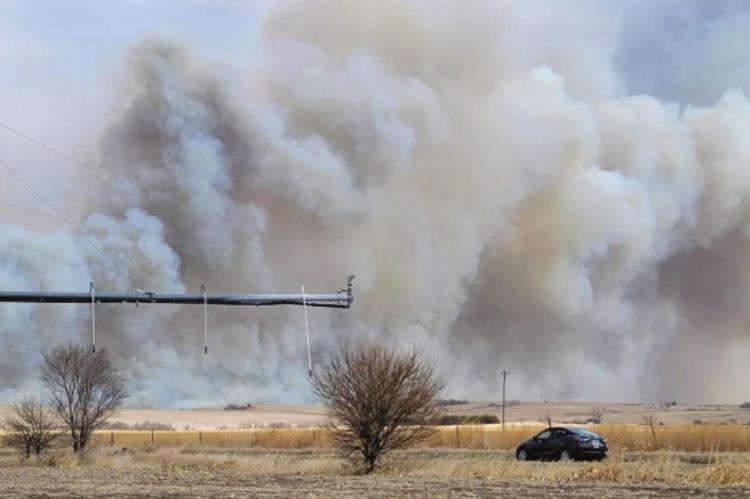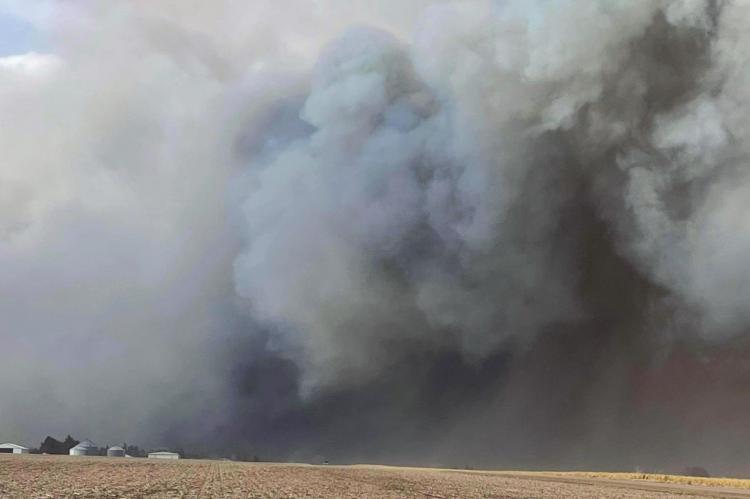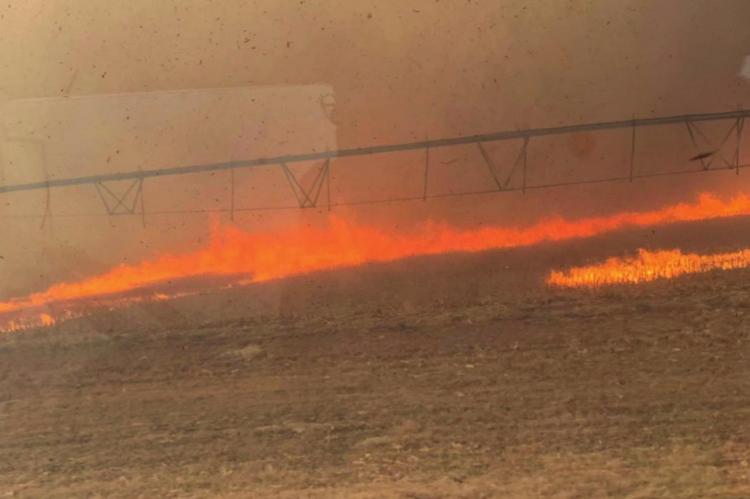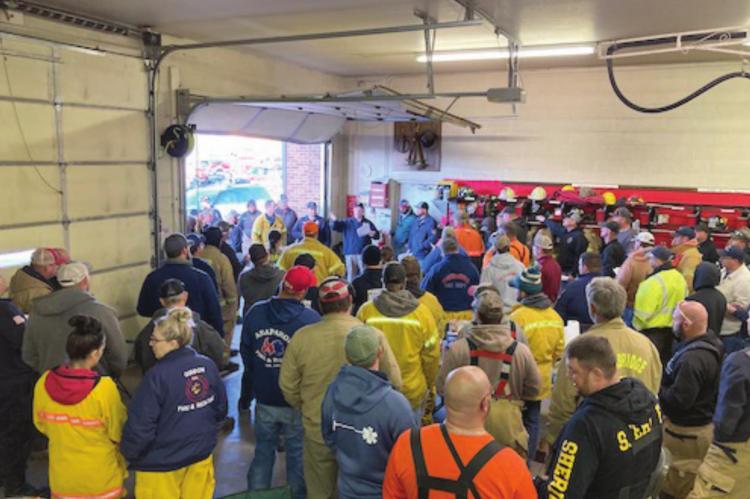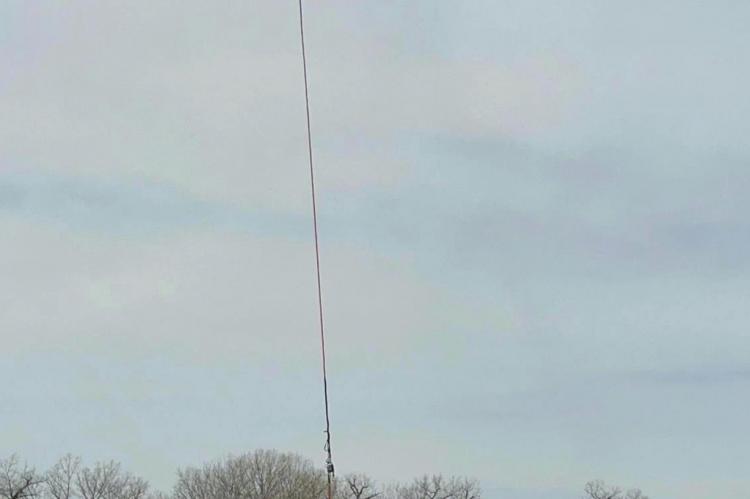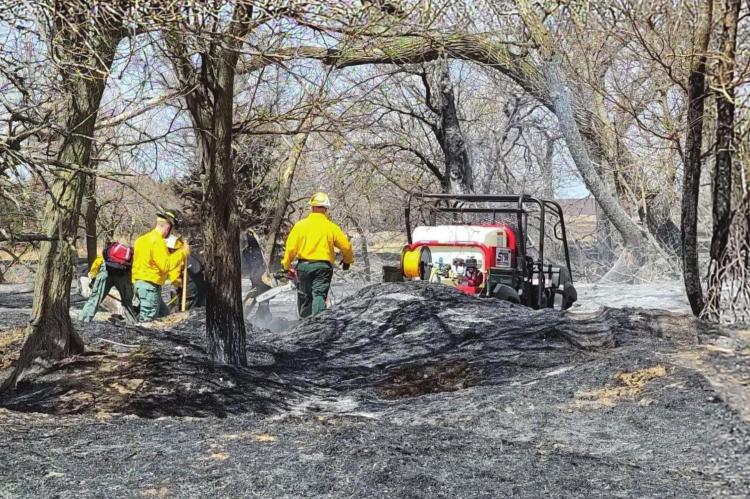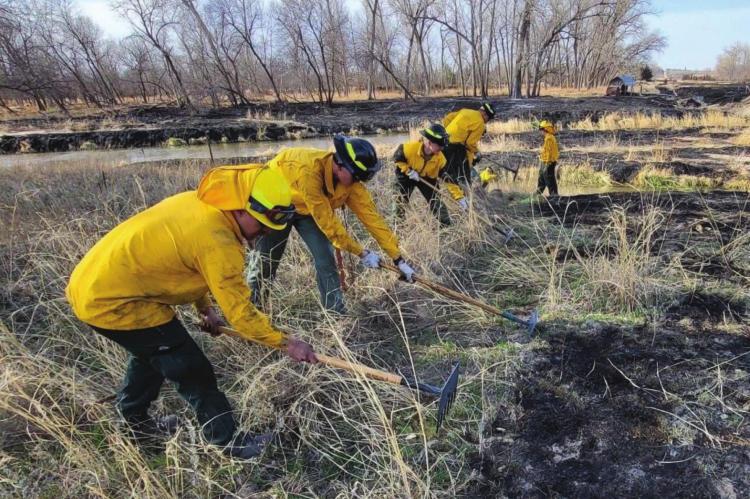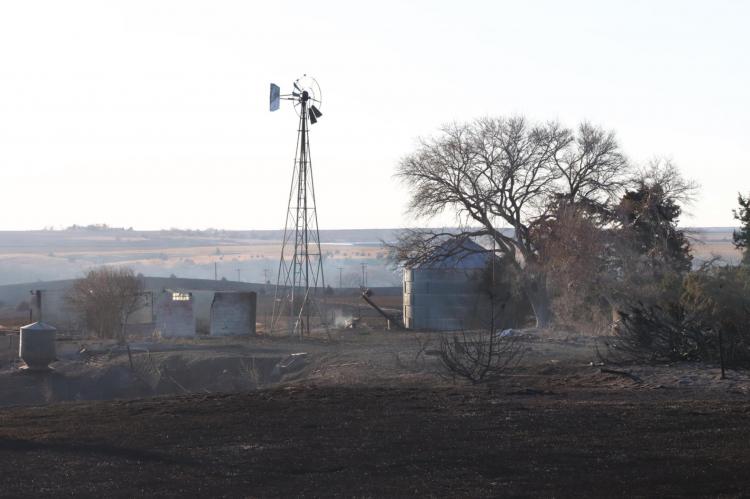“I would have never thought it possible”
Recounting the efforts and events of battling the ‘739 Fire’ to save people, property
Rural residents of the Plains of are always in tune with the weather. On a sultry summer evening when the wind shifts to the East, they don't need a weatherman to tell them a storm is on the horizon. On a clear winter night without a cloud in the sky, they don't need a forecas to know it'll be a bitterly cold start to the next day.
On Thursday, April 7, the weather had a threatening feel, but not a familiar one. Moisture had been scarce for months and humidity levels, which typically range from 40-60 percent in April, had plummeted to the teens. With dry air and parched soil, conditions were already ripe for fire danger. To make matters worse, winds howled from the northwest at a steady 35 mile per hour with gusts touching 60.
There was no warning needed from the National Weather Service, but the warnings were issued anyway A High Wind Warning, A Red Flag Warning and a Blowing Dust Advisory were issued.
Between intuition and requisite warnings, there could be no missing the fact the region was sitting on a powder keg hoping no one or no thing lit the fuse.
At 12:33 p.m. that Thursday, Furnas and Gosper County Emergency Manager Roger Powell was sitting in a conference for emergency managers across the State in Grand Island. His phone sent him a startling notification.
As an emergency manager, Powell receives what he called hotspot notifications from the National Weather Service. The notifications are an indication of a potential fire. They provide a latitude/ longitude location of the hotspot and he was quickly able to see where the fire might be located.
Powell dismissed himself from the conference session he was in and went into the hallway to call Elwood Fire Chief Darren Krull.
The page went out at 12:34 p.m. that Thursday afternoon. As firefighters from the Elwood, Holbrook and Arapahoe Volunteer Fire Departments were sitting down to lunch, their biggest fears were being realized.
When Krull received Powell’s phone call, he had just received the page and told Powell firemen were on their way.
Powell gathered his things as he knew his time at the conference had come to and end. While he headed out of Grand Island and back to the area, he and Krull exchanged three or four phone calls.
“I wasn’t too worried yet, but I could tell that Darren was stressed,” Powell said. “He just kept saying, ‘We’ve got a mess - we can’t catch up to it.’”
Back at the fire, Holbrook Fire Chief Wesley Hock remembers there wasn’t much delay in requesting more mutual aid in short time. Oxford and Edison were paged soon after. Departments from Eustis, Farnam, Cambridge and Bertrand were also brought in.
Hock estimates the fire moved at a clip of 50-60 miles per hour at times. As soon as one fire line might be controlled, burning debris and embers would catch a ride in a wind gust and re-ignite more grass, cornstalks or wheat stubble 50-100 yards away.
Furnas County Sheriff Doug Brown said he remembers a number of times when radio traffic would indicate some control over the blaze, only to have another fire start somewhere else.
Just before 3 p.m., a traffic alert was issued that visibility on U.S. Highway 283 was minimal. The fire was raging and crews were struggling to slow it down.
Rural Arapahoe resident Cammie Kerner first learned of the fire situation at 2:30 Thursday afternoon when Arapahoe Public Schools issued a beacon message that there would be no bus services north of Arapahoe because of the fire.
Kerner had been called away to work in Minden that day and wasn’t in a position to leave early, so she called a neighbor, Drew tenBensel.
“I said, ‘What you doing, Drew?’”
“Fighting a fire, Cammie.”
“Do I need to be worried about the fire?”
“Not yet.”
Soon thereafter, Kerner’s son Levi, a senior at Arapahoe Public Schools, called his mom and asked if he could skip track practice set sprinklers at their home, which is about two miles east and two miles north of Arapahoe.
“No, you keep your butt in school.”
But Kerner soon had a co-worker share a map that showed where the fire was. It also included arrows indicating the direction the fire was moving. For the first time, she became a bit uneasy.
She called her husband, Darin, and told him to head home from work. She called her son again with the sudden change in plans.
“Get your butt home - grab what you can, grab the dog and get out of there.”
The Kerner men made not only one trip, but a few over the course of the next couple hours. Cammie still couldn’t leave work, but said she wasn’t worried about them trekking back and forth between their home and Arapahoe.
“I couldn’t be worried about it because I didn’t know they were doing it.”
Powell arrived on scene mid-afternoon and said he started getting worried when the fire jumped Highway 283.
Fire crews continued to battle and farmers with tractors and discs would work along with grass rigs, trying to create fire barriers around rural residences and other structures. But the fire just kept moving.
The smoke was intolerable and made visibility almost non-existent. Because not all fire departments were in the same mutual aid networks, radio communication wasn’t always possible.
Hock and Arapahoe Fire Chief Brian Sisson coordinated efforts from the south side of the fire while Krull coordinated the response from the north side. But it was time for the two sides to meet and brainstorm a plan to get the fire slowed down and stopped as it moved southeast toward Furnas County.
Krull and Phelps County Emergency Manager Justin Norris jumped in a Ford Expedition and headed south from their station near the junction of Highway 283 and Highway 18 and headed south to the Furnas County Roads shop a few miles north of Arapahoe.
Calamity struck just after 5 p.m. while the two men were on their way. With visibility estimated at 10-20 feet from intense smoke and blowing dust, the Expedition Norris and Krull were traveling in hit head-on with a truck hauling water for the fire fighting efforts.
“The accident was just another grenade into the pile of everything that was going on,” Brown said. “We couldn’t tell from the 911 call exactly what happened, but we knew it was a very serious situation and it was going to be dangerous.”
Brown said a party of 12 people formed the crew that responded to the accident.
As he headed north up the highway, he didn’t know exactly where the accident had occurred. Visibility was still a major problem.
“It felt like you couldn’t see the windshield wipers on your vehicle,” Brown said. “It was one of those calls where you weren’t sure if you were going to make it back.”
Logan Baker, a nine-year member of the Cambridge Volunteer Fire Department, was out working on a grass rig with fellow firefighter Bronson Soucie. The two were only a quarter-mile away from the scene and were the first to arrive there.
“It’s hard to explain just how bad the visibility was, but you literally could not see anything until you were on it - we first saw the vehicle when we were about 10-15 feet away from it,” Baker said.
Baker is in the process of becoming an EMT as well and said he and Soucie approached the driver’s window and Norris, the driver, was able to answer questions. It became apparent that they would not be able to open either the driver door or the passenger door where Krull was seated.
The two, along with the aid of other crews that soon arrived, were forced to use the jaws to cut the doors open and extract the two men. The job was made more difficult because of the smoke, wind and other elements that made it difficult to see well.
Krull was killed in the accident while Norris had very serious injuries. The driver of the truck carrying water was not seriously injured.
To make matters worse, it was getting hot as the fire was approaching. Brown said it had crept up under Baker and Soucie’s grass rig before they had departed.
“The men and women that went up into that thing deserve a pat on the butt,” Brown said. “No one blinked when it was time to go and everyone did their job.
“It would’ve been real easy to get in there and panic - no one did. It was as time-critical as any medical transport I have been involved in and the crew that went up there saved a life.”
Norris was transported to the hospital in Cambridge with life-threatening injuries. He was then transferred to Good Samaritan Hospital in Kearney in stable condition. He has since been transferred to a hospital in Omaha and is said to be progressing in his recovery.
Krull was what other firefighters call a real firefighter.
Delaine Soucie, Fire Chief at Cambridge, said his life of service to fire fighting speaks for itself.
“I think he slept, ate it and drank it,” Soucie said. “He had 36 years of service at the age of 54, 18 of those as Chief. He was as good at it as there was around.”
Soucie knew Krull and his wife, Cheryl, from childhood as they grew up in the same neighborhood of Clay County near Glenvil and Fairfield.
Powell worked with Krull through his role as emergency manager for the past few years and the two became friends.
“Darren was a very passionate and knowledgeable firefighter and EMT,” Powell said. “He was a true servant to his community.” Powell added that when he needed anything, Krull was the kind of guy he could call for help.
He also said he will always remember the funeral and subsequent processional from Elwood to Glenvil.
“The processional had to be miles long, but all along the way, there were those that stopped and paid respects - school children from Loomis and Holdrege, fire trucks lined along the highway from each community we passed by, construction workers, law enforcement - it was all real special.”
The fire continued to rage. Shortly after the accident, Highway 283 was officially closed from Elwood to Arapahoe. Evacuations continued for families and rural residents that lived in areas north and northeast of Arapahoe.
A meeting of leaders was set up at the airport to discuss evacuations for Arapahoe and Edison.
Memories were mixed on the level of concern that the fire would travel to Arapahoe. Some said they were hopeful throughout that the fire would miss it to the East. Others didn’t share that same hope. In the end, Arapahoe was put on a pre-evacuation notice, meaning residents should be prepared to evacuate at a moment’s notice.
The decision was also made to evacuate Edison if the fire traveled south of Highway 6/34.
One of the rural evacuees was Mark and Linda Hamel, who live about six miles northeast of Arapahoe.
First of all, Mark was not in great physical shape after a fall from a ladder he had suffered three days earlier. The fall left him with about a dozen stitches in the back of his head and some injuries to his shoulder, along with the aches and pains that go with it.
Despite those aches, he headed back to his acreage on a Ranger utility vehicle. He found a solid firebreak had been created to the north to protect his windbreak, but the fire was still threatening his home.
He traveled back down to the road to search for fire trucks and saw two near his driveway, but they left before he could get them back up to his house. Two friends, Ward and Colby Carpenter, arrived and Hamel jumped into their truck with them and convinced them to drive back up to the place.
“When we got back up there, we found my shop was a raging inferno,” Hamel said.
On the west end of his garage, which is attached to the west end of his home, there is a walk-out door that had blown in and the door frame was catching fire.
Hamel said they hooked up a garden hose and began dousing the fire with water. About the time the fire was just about out, Hamel said the power went out, which meant the water stopped flowing.
“So I looked in the fridge and we had two gallons of milk in there,” he said. “We used those two gallons of milk and got the fire put out.”
They weren’t out of the woods just yet and the Carpenters convinced Hamel that with no water, they had to leave. The fire was still intensifying.
When they got back down to the road, they met a truck carrying water. Two grass rigs were shortly behind and the crews headed back up to the house. Before long, there were six trucks on site to protect the Hamel’s home.
In the end, their home was saved with some damage to the north side, where the siding is warped and there are some cracks in the triplepaned windows.
“People keep asking me if I was scared or afraid,” Hamel said. “No, I was pissed off and I wanted to save my house.”
The situation for firefighters was grim. At times, firefighters wouldn’t know where the fire was until they met it face-to-face.
Delaine Soucie, who’s been on the Cambridge squad for more than 20 years, said he had been in a bad grass fire near the lake north of Cambridge that was bad because of horrible north winds in the middle of winter, but it didn’t compare to this.
“It really was kind of hopeless,” Soucie said. “You’d be spraying and take out a fire line and you’d look back and you’d just see fire.”
Still, they had to try everything they could to slow it down.
Embers blowing spread the fire at incredible rates.
“You would drive down the road and it almost looked like the gravel was on fire - it was all the embers blowing across.”
Baker considers himself a fire fighting junkie. He watches all the movies and television shows that are made on fire fighting. He said even Hollywood couldn’t come up with something on par with the conditions.
“We were all playing a very scary game,” Baker said. “But it’s your job, so you go out and do it. Hopeless is a good word, but you obviously have to do everything you can.”
Firemen said that water is always key, but access to it was difficult, though a number of community members stepped up to haul water to firefighters throughout the area. Typically, if crews can get water to a wildfire, it can play a big role in getting it under control. But there wasn’t enough water to be had to fight the blaze that stretched across a swath nearly three miles wide in parts.
Many firefighters were on duty from Thursday afternoon until Friday morning or even later into the day Friday, pushing the line where fatigue met adrenalin.
For hours, firemen battled the blaze across a 20-plus-mile path of Gosper and Furnas counties, battling a blaze that felt like the gates of hell.
“I think I met the devil a couple of times while we were out there,” Soucie said.
Hock and Sisson continued to coordinate efforts as Incident Commander, eventually setting up shifts that they exchanged every 12 hours over a span of days into the following week. Division Supervisors would check in with the Commanders to work the most effectively at containing the fire.
As the night wore on, between 26 and 37 fire departments joined the fray, providing relief to some weary firemen who had been fighting the fire for over 12 hours.
Strike teams from as far west as Alliance worked together. A strike team consists of one vehicle and several firefighters from 5 or 6 departments in that region. This leaves most of the crew and fleet of vehicles at home to cover any emergencies that might occur there. “Strike teams know how to do a job and get it done right,” stated Hock.
Baker had to leave the next morning for National Guard drills, but stayed on until after midnight.
“I will never forget this fire and the reason is that I hope this never happens again,” he said. “You always go to a fire and think ‘Well it could’ve been worse,’ but I think this had to be about as bad as it gets. This sets the bar for what ‘worse’ actually is.”
The fire continued on and hit the benchmark to trigger the evacuation of Edison. Some families had time to grab some possessions, while others were not around to get back to their homes. Others were pressed for time.
The fire had moved very quickly when it approached Highway 6/34.
“The fire went from a mile north of 6/34 to the river in what seemed like the blink of an eye,” Brown said.
Dave and Sheila Swisher reside in Edison, but were set to close that evening on a place west of Edison where their greyhound hunting dogs reside.
Swishers didn’t know how big of a problem the fire was until a friend called when they were on their way home from work.
“Around 5:30 or so a friend called us and told us that we need to get home to our dogs,” Sheila said.
When they arrived to Edison, traffic was limited to residents, but the couple rallied some friends and trailers and headed to the farm to pick up the dogs.
The loading took about 15 minutes and the smoke was intensifying to the point visibility was waning.
The company made it out with the dogs in tow, just in time. They’d return later to find the house on the property, which had survived the ‘35 Republican River Flood, was gone as were their dog houses and some other equipment from around the property.
Cammie Kerner knew she couldn’t get back to Arapahoe because Highway 6/34 had been closed from Arapahoe to the Oxford junction, so she stayed in Holdrege with family.
She had received word from ten-Bensel that neighbors had evacuated and a text from her husband that said “the trees are on fire.” She was operating under the assumption that there place would be gone.
Then she got a phone call from Colby Carpenter.
“Hi Cammie, I am standing on your deck.”
Kerner was astonished. To this day, she still isn’t sure how their house was spared because there’s an exact line on their property of where the fire reached and where it stopped.
“I don’t know of any other word than blessed,” Kerner said. “How can I still have my home? That’s just where my head and my heart are at - we’re extremely blessed.”
Firefighters were able to stand in and protect a number of homes while some others were not so fortunate.
According to a report from the Nebraska Emergency Management Agency (NEMA), eight structures and dozens of outbuildings were destroyed in the fire.
“Fire doesn’t discriminate, it doesn’t care who you are or how much money you have,” Hock said. “It will destroy everything without warning.”
As the fire headed south and reached the Republican River, fire crews finally caught a couple small breaks.
The crews learned that the natural typography of the land and riverbed was working in their favor. With the fire now in the valley the winds were not as strong. They finally had a chance to stop the beast.
The river itself created a bit of a fire break and there were a number of grass rigs piled up along the river, dousing the fire with water. Mother nature was still trying to fuel the flames, but crews persisted and the fire was halted Thursday night.
Still the work was far from done.
Brown said cress fought to protect structures from fires throughout the area throw the night. Trees that had caught fire would continue burning for days if not weeks until they burn up all the fuel from within.
There was also a continued fear that if the win had shifted, there would be more disasters to fight.
“There was still enough burning and enough fuel that if the wind had shifted the wrong way, it could have gotten to Arapahoe,” Brown said.
Powell said a road bridge had burned out on a rural road and he wanted to make sure the road was closed before someone happened to drive into a massive hole.
“Driving out there in the middle of the night - it’s pitch black, but you can see the light of fire everywhere,” Powell said. “It was really eerie.”
There would be no rest overnight.
Friday morning, Powell typed up a disaster declaration for Gosper and Furnas counties and had both county clerks and county boards sign it.
Soon, NEMA was on its way and State resources arrived to help the tired response team.
Powell also requested a pair of helicopters and a 24-member hands team from the National Guard. The helicopters collected tubs of water from the Republican River or other water sources and poured it over hotspots.
The hands team, which Powell said was newly organized and might have been on their first deployment, walked the river bed with rakes and shovels, working over hotspots and extinguishing flames. “The state’s
“The state’s response was pretty fast,” Powell said. “It was welcome relief.”
State assistance lasted through the weekend and into Monday and some into Tuesday.
There were scary moments along the way, such as hotspots that began to spread into new fuel areas, but with crews patrolling and on standby, those were controlled fairly quickly.
“I don’t think Brian (Sisson) and Wes (Hock) took a breath until Tuesday,” Brown said.
After almost 2 weeks since the start of the blaze, Sisson reports that the fire is 80% contained. “We will be fighting this
“We will be fighting this for several more weeks.” With hot spots still popping up and trees still smoldering and a continued search for rain, the chance of fire is still very great. “The trees will continue to smolder from the inside until something puts them out or they’ve consumed everything from the inside out.”
With a scalped landscape, blowing dust and dirt continues to be a problem as Highways 283 and 6/34 continued to be closed for periods of time into last Wednesday, though neither had to be closed again since.
The weather still hasn’t changed much with winds expected to blow across a the scorched area for the remainder of the week.
“This is a danger that is not going away in the near future,” Brown said.
Firemen will have to stay on the ready.
“We are preparing for the worst. Something bad could happen at any time,” Hock said. “We need people to be safe and respect the burn bans. We are trying to save peoples lives and property and people need to get out of the way so we can do our jobs. They need to stay out of the way of the fire department and first responders.”
Powell said there will be time to reflect and evaluate. He’s sure there are things that everyone has learned that will help make future responses better, but for now, he’s just thankful for the incredible effort and sacrifice of so many volunteers.
“You can’t say enough about our volunteers,” Powell said. “To see what they would look like when they came in for a break or to get a bite to eat...”
He’s also ready to face the fact that something he never thought was possible just happened to his counties.
“I have thought about things like this for a long time,” Powell said. “I could have never imagined this was possible. I was wrong about that.”
“I think I met the devil a couple of times while we were out there.”
-Firefighter Delaine Soucie

